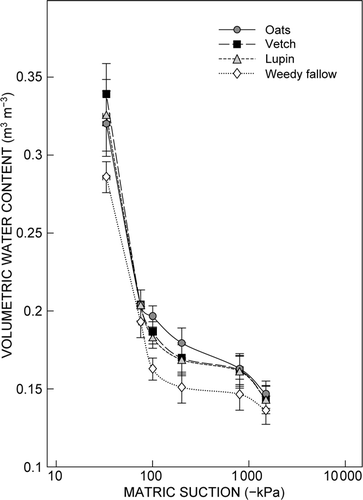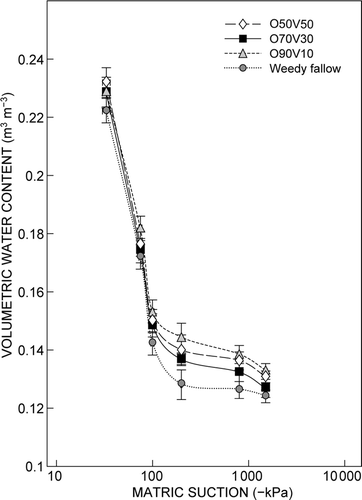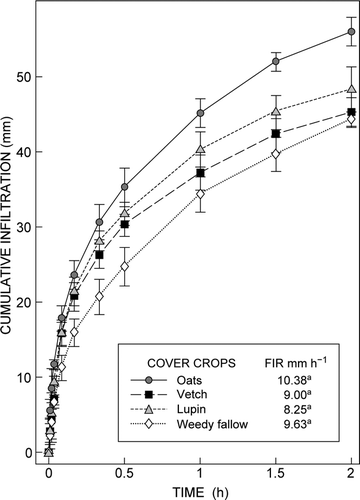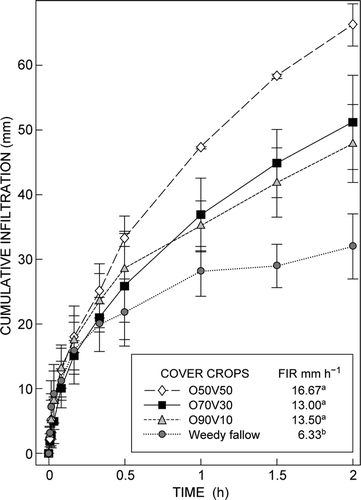Abstract
There is substantial evidence that cover crops increase soil fertility and plant nutrition but the few studies concerning soil physical properties are conflicting. This study determined the effects of monocultures of vetch (Vicia dasycarpa L.), lupin (Lupinus angustifolius L.), oats (Avena sativa L.) and bicultures of oats and vetch and a weedy fallow on the strength and water conservation properties of a hardsetting Oakleaf soil. Oats monoculture lowered the soil strength by 48.5%, whilst vetch and lupin increased soil strength by 43% and 31%, respectively, relative to the control. Bicultures decreased soil strength as the proportion of oats increased. Oats monoculture increased cumulative water infiltration relative to the control. Bicultures increased the water final infiltration rate by 105–163% compared to the control. Plant available water increased by 24–28% compared to the weedy fallow under monocultures. However, no significant differences were observed on plant available water after two rotations with bicultures compared to the weedy fallow. We concluded that oats monoculture reduced the strength and improved water conservation properties of the hardsetting soil but vetch and lupin monoculture worsened the deleterious effects of the hardsetting phenomenon.
Introduction
Advocates of sustainable agriculture are shifting from agronomic practices such as tillage to conservation agriculture (CA) to boost soil fertility and increase crop yields (Thierfelder and Wall Citation2009). Many CA studies are concerned with the artificial causes of soil degradation such as tillage. Natural causes of soil structure degradation have received less attention. One major cause of natural soil structure degradation is hardsetting (Mullins Citation2000). A soil exhibiting hardsetting characteristics is hard, structureless and difficult to cultivate when dry. Hardsetting soils have a narrow range of workable soil moisture contents and increase in strength over a narrow change in water content within the plant available range (Chan Citation1995). High soil strength and loss of structure reduces water infiltration and water retention (Ries and Hirt Citation2008).
The role of winter cover crops in sustainable CA is well recognised (Villamil et al. Citation2006). Legume cover crops such as vetch (Vicia villosa L.) and clover (Trifolium repens L.) add to soil nitrogen (N) through the N-fixation process (Sainju et al. Citation2007). In general, grass cover crops such as rye (Secale cereale L.) and oats (Avena sativa L.) produce persistent and higher biomass than legumes (Ranells and Wagger Citation1997, Wang et al. Citation2012). Moreover, grasses use residual N more effectively than legumes, thus preventing N leaching (Campiglia et al. Citation2009). Therefore, in many CA systems, cover crop species have been selected based on the N-fixation capacity and biomass quality and quantity. Whereas substantial evidence that cover crops increase soil fertility and crop yields is abundant and uncontestable (Thierfelder and Wall Citation2009), the few studies concerning soil physical properties are conflicting. For example, Dabney et al. (Citation2001), Fageria et al. (Citation2005) and Villamil et al. (Citation2006) found that cover crops improved the bulk density and water retention capacity of different soils. In contrast, Grant and Lafond (Citation1993), Osunbitan et al. (Citation2005) and Abiven et al. (Citation2009) reported that cover crops either increased or had no effect on soil strength. These inconsistent and contradictory results are aggravated by the fact that soil responses to agronomic practices are also influenced by soil type and climate (Bescansa et al. Citation2006). The objective of this study was to determine the effects of winter cover cropping under a maize-based CA system on a hardsetting soil's strength and water conservation status in the Eastern Cape province of South Africa.
Materials and methods
Site description and climate
The study was conducted at the University of Fort Hare research farm near Alice in the Eastern Cape province of South Africa. The site is situated at an altitude of 508 m above sea level (32°47'47′ S, 26°50'56′ E). The area has a warm temperate climate with an average annual rainfall of 575 mm received mainly during the summer months, October to April, with an average temperature range from 19 to 23 °C. The soil is classified as the Oakleaf form (Land Type Survey Staff Citation2001). The parent material is alluvial and the soil mineralogy is dominated by mica, with low amounts of quartz and kaolinites. The soil texture is sandy loam with a slightly acidic reaction (Nciizah and Wakindiki Citation2012). Some of the characteristics of the soil at the experimental site are listed in .
Table 1 : Some properties of the sandy loam Oakleaf soil at the experimental site in Alice (sources: Mandiringana et al. Citation2005, Nciizah and Wakindiki Citation2012)
Prior to the establishment of the trials in 2007, conventional tillage was practiced on the site with various crops being grown. However, no tillage was practiced during this study. Cover crops were planted in trenches, 0.25 m apart and 0.2–0.3 m deep dug using hand hoes. After reaching the flowering stage, all cover crops were killed with glyphosate (360 g l−1) applied at 5 l ha−1. Maize (Zea mays L.) was planted using manual hand-jab planters commonly known as matraca.
Experimental design and treatments
Two experiments were conducted, one involving growing the winter cover crops as monocultures and the other as bicultures in rotation with maize in summer. Treatments were arranged in a split-plot randomised complete block design with three replications. The slope constituted the blocking factor; the main plots were the cover crops and the two soil depths constituted the subplots. Sampling and measurements were taken in October 2010 at two soil depths: 0–0.15 m and 0.15–0.3 m. The timing for sample collection for the studies was chosen because, at this time, there was no fresh winter cover crop biomass addition to the soil, thus it was deemed ideal for assessing cumulative effects of the treatments. Supplementary overhead sprinkler irrigation was applied whenever it was necessary.
Monoculture experiment
Four treatments, namely vetch (Vicia dasycarpa L. cv. Max), oats (Avena sativa cv. Sederberg), lupin (Lupinus angustifolius L. cv. Tanjil) and a control, which was weedy with no cover crop, were studied. The cover crops were first planted on 1 June 2007 and subsequently on the same date in 2008, 2009 and 2010. No inorganic fertiliser was applied to the cover crops but the legumes were inoculated with Rhizobium leguminosarium before planting.
Biculture experiment
Vetch and oats were chosen in this study on the recommendation of Murungu et al. (Citation2010), who worked on the same cover crops. The cover crop bicultures were first planted on 30 April 2009 and subsequently on 20 May 2010. The cover crops were planted as bicultures at different seeding percentages. The treatments were thus the different biculture ratios, i.e. 90% oats plus 10% vetch (O90V10), 70% oats plus 30% vetch (O70V30), 50% oats plus 50% vetch (O50V50) and the control, which was left weedy with no cover crop. The percentage refers to the percentage of the recommended seeding rate that is used in monocultures, which is 100 kg ha−1 for oats and 50 kg ha−1 for vetch.
Soil strength
Soil strength was determined as soil penetration resistance using a hammer-type dynamic cone penetrometer (Herrick and Jones Citation2002). The penetrometer had a 30° hardened steel cone with a 20.3 mm diameter shaft. The 2 kg hammer was raised until it touched the collar and then released to drop through a 0.65 m height to hit the striking plate. The total number of blows required penetrating a depth of 0–0.15 m and 0.15–0.3 m was recorded. Each strike contained the equivalent kinetic energy of 12.74 J as described by Herrick and Jones (Citation2002). Ten penetrometer measurements were recorded at each plot and gravimetric water content was simultaneously determined and later used as covariates in the statistical analysis of soil strength.
Infiltration rate
Infiltration rate was determined using a double ring infiltrometer (Eijkelkamp Agrisearch Equipment, 6987 ZG, Giiesbeek, The Netherlands). Plant debris were carefully removed from the surface ensuring the soil was not disturbed. The rate at which water infiltrated into the soil was measured using the measuring rod in the centre of the cylinder (Reynolds et al. Citation2002). Final infiltration rate (FIR) was assumed to have been reached when three consecutive readings remained constant. Three measurements were recorded in each plot.
Water retention
The pressure plate apparatus (Soil Moisture Equipment Corp., Goleta, California, USA) was used to determine water retention properties of the soil. Disturbed soil samples passed through a 2 mm sieve were used for the water retention measurements (Dane and Hopmans Citation2002). The ceramic porous plates were first saturated for 24 h in 0.005 M CaSO4 solution. The soil samples were contained in polyvinyl rings 0.02 m in height and 0.045 m diameter. Three replications were used for each plot. The soil samples were packed in the polyvinyl rings at a bulk density of 1 600 kg m−3, the average bulk density of the soils in the field. The soil samples were then directly placed onto the ceramic plate surface and saturated with 0.005 M CaSO4 for 24 h. The ceramic plate with the soil samples was transferred to the pressure chamber and air forced in at 33, 75, 100, 200, 800 and 1 500 kPa. Equilibrium was determined once outflow of water from the pressure chamber had ceased and this took from 24 h to 17 d depending on the pressure. Volumetric water content was obtained by multiplying the gravimetric water content values with soil bulk density. The volumetric water content was plotted against the matric suction values to produce the soil-water characteristic curves.
Statistical analysis
Analysis of variance for a split-plot randomised complete block design was performed using the JMP® Release 9.0 statistical package (SAS Institute, Inc., Cary, North Carolina, USA, 2010). Mean separations were performed using Fisher's protected least significant difference (LSD) test at P ≤ 0.05.
Results
Soil strength
Cover crop monocultures significantly (P ≤ 0.05) affected the soil strength depending on the soil depth (). Within the 0–0.15 m depth, oats lowered the soil strength by about 51% but vetch and lupin had no significant effect compared to the control. In the 0.15–0.3 m depth, oats monoculture also lowered the soil strength by about 46%, whereas vetch and lupin increased soil strength by about 43% and 31%, respectively, relative to the control. In the biculture experiment, significant (P ≤ 0.05) differences in treatment means were observed only in the 0.15–0.3 m depth (). Soil strength was significantly (P ≤ 0.05) decreased by the O90V10 treatment relative to the control. In general, soil strength was significantly (P ≤ 0.05) higher in the 0.15–0.3 m depth relative to the 0–0.15 m depth in all treatments ().
Table 2 : Penetration resistance (J) in a sandy loam Oakleaf soil as affected by cover crop monocultures after four rotations. Within depths, means followed by the same lower-case letter are not significantly different at P ≤ 0.05. In each column, means followed by the same upper-case letter are not significantly different at P ≤ 0.05. Values in parentheses are the coefficient of variation (CV; %)
Table 3 : Penetration resistance (J) in a sandy loam Oakleaf soil as affected by cover crop bicultures after two rotations. Within depths, means followed by the same lower-case letter are not significantly different at P ≤ 0.05. In each column, means followed by the same upper-case letter are not significantly different at P ≤ 0.05. Values in parentheses are the coefficient of variation (CV; %)
Water conservation
Infiltration
Oats monoculture significantly (P = 0.05) increased cumulative water infiltration relative to the control but not FIR (). Cover crop bicultures significantly (P = 0.05) increased both cumulative water infiltration and FIR compared to the control (). Treatment O50V50 resulted in the highest cumulative water infiltration among the treatments. The treatments O50V50, O70V30 and O90V10 resulted in a respective 163.3%, 105.4% and 113.3% increase in the FIR compared to the control.
Water retention
Cover crop monocultures resulted in about 22–28% increase in plant available water compared to the control (). At soil water matric suction of -33 and −100 kPa, a significant (P ≤ 0.05) increase in water retention was observed among cover crops relative to the control, which retained the lowest amount of water (). Most of the water retained in the soil was released between -33 and -200 kPa. Although cover crop bicultures did not affect the plant available water (), water retention was higher under the cover crop bicultures as the soil dried beyond −100 kPa ().
Figure 3: Water retention characteristics in a sandy loam Oakleaf soil under cover crop monocultures after four rotations. Error bars indicate SD

Figure 4: Water retention characteristics in a sandy loam Oakleaf soil under cover crop bicultures after two rotations. Error bars indicate SD

Table 4 : Plant available water (m3 m−3) in a sandy loam Oakleaf soil as affected by cover crop monocultures after four rotations. Different letters within a column indicate a significant difference among treatments at P ≤ 0.05. Values in parentheses are the coefficients of variation (CV; %). FC = Field capacity, WP = wilting point, PAW = plant available water
Table 5 : Plant available water (m3 m−3) in a sandy loam Oakleaf soil as affected by different cover crop bicultures after two rotations. Values in parentheses are the coefficient of variation (CV; %). FC = Field capacity, WP = wilting point, PAW = plant available water
Discussion
Cover crops affect soil properties mainly through organic carbon (Wang et al. Citation2012) and live surface mulching effects (Folorunso et al. Citation1992, Astier et al. Citation2006). In general, addition of organic matter in the soil lowers soil strength as observed in this site by Nciizah and Wakindiki (Citation2012). Nevertheless, in the present study soil strength decreased under the cereal (oats) but increased under the legume monocultures (vetch and lupin) (). Since grass cover crops produce more persistent biomass than most legumes (Ranells and Wagger Citation1997, Wang et al. Citation2012), it is likely that the persistence of oats biomass was critical in lowering soil strength. Furthermore, legume cover crops produce fast-growing biomass, which increases their relative water demand (Murungu et al. Citation2010). Increased water loss from the soil could have triggered hardsetting in the soil. Hardsetting soils have a narrow range of workable soil moisture content and increase in strength after a small change in water content (Chan Citation1995, Nciizah and Wakindiki Citation2012).
Cereals such as oats are known to have dense root mass, which leave intact channels after decomposition (Jokela et al. Citation2009). Given that the infiltration process is greatly affected by pore clogging (Baumhardt and Jones Citation2002, Verhulst et al. Citation2010), it was plausible to attribute infiltration results ( and ) to the nature of the root system and the propensity of the cover crops to add to soil organic carbon and lower soil strength. Therefore, when oats was grown in monoculture, it allowed more water to infiltrate into the soil profile relative to the legumes and the control but the FIR did not change. However, when oats were grown in biculture with vetch both cumulative infiltration and the FIR significantly increased relative to the control. Therefore when oats monoor bi-cultures reduced soil strength, cumulative infiltration and water retention increased. However, only bicultures increased FIR. The results of the present study agree with those of Folorunso et al. (Citation1992) and Astier et al. (Citation2006), who observed higher infiltration rates under oats and vetch cover crops compared to a weedy control owing to reduced surface sealing.
The improved water retention capacity under cover crops ( and ) was also attributed to added organic matter by the cover crops. Increased soil organic matter increases the number of micropores, which are responsible for retaining water within the plant available water range (Bescansa et al. Citation2006). Soil texture was the same in all treatments (), so did not contribute to the variation in water retention.
Conclusion
Both oats mono- and bi-cultures reduced soil strength and increased cumulative infiltration and water retention but only bicultures increased FIR. Legume monocultures increased soil strength and did not affect the water status in the hardsetting Oakleaf soil.
Acknowledgements
Funding was provided by the Govan Mbeki Research and Development Centre of the University of Fort Hare through grant number C104 and a supervisor-linked bursary to the senior author.
References
- Abiven , S , Menasseri , S and Chenu , C. 2009 . The effects of organic inputs over time on soil aggregate stability – a literature analysis . Soil Biology and Biochemistry , 4 : 1 – 12 .
- Astier , M , Maass , JM , Etchevers-Barra , JD , Pena , JJ and Gonzalez , FD. 2006 . Short-term green manure and tillage management effects on maize yield and soil quality in an Andisol . Soil and Tillage Research , 88 : 153 – 159 .
- Baumhardt , RL and Jones , OR. 2002 . Residue management and paratillage effects on some soil properties and rain infiltration . Soil and Tillage Research , 65 : 19 – 27 .
- Bescansa , P , Imaz , MJ , Virto , I , Enrique , A and Hoogmoed , WB. 2006 . Soil water retention as affected by tillage and residue management in semiarid Spain . Soil and Tillage Research , 87 : 19 – 27 .
- Campiglia , E , Paolini , R , Colla , G and Mancinelli , R. 2009 . The effects of cover cropping on yield and weed control of potato in a transitional system . Field Crop Research , 112 : 16 – 23 .
- Chan , KY. 1995 . Strength characteristics of a potentially hardsetting soil under pasture and conventional tillage in semi-arid region of Australia . Soil and Tillage Research , 34 : 105 – 113 .
- Dabney , SM , Delgado , JA and Reeves , DW. 2001 . Using winter cover crops to improve soil and water quality . Communications in Soil Science and Plant Analysis , 32 : 1221 – 1250 .
- Dane JH Hopmans JW 2002 . Water retention and storage . In: Dane JH Topp CG , Methods of soil analysis. Part 4: Physical methods . Book Series no. 5 . Madison : Soil Science Society of America . pp 671 – 720 .
- Fageria , NK , Baligar , VC and Bailey , BA. 2005 . Role of cover crops in improving soil and row crop productivity . Communications in Soil Science and Plant Analysis , 36 : 2733 – 2757 .
- Folorunso , OA , Rolstona , DE , Pricharda , T and Louia , TD. 1992 . Soil surface strength and infiltration rate as affected by winter cover crops . Soil Technology , 5 : 189 – 192 .
- Grant , CA and Lafond , GP. 1993 . The effects of tillage systems and crop sequences on soil bulk density and penetration resistance on a clay soil in southern Saskatchewan . Canadian Journal of Soil Science , 73 : 223 – 232 .
- Herrick , JF and Jones , TL. 2002 . A dynamic cone penetrometer for measuring soil penetration resistance . Soil Science Society of America Journal , 66 : 1320 – 1324 .
- Jokela , WA , Grabber , JH , Karlen , DL , Balser , TC and Palmquist , DE. 2009 . Cover crop and liquid manure effects on soil quality indicators in a corn silage system . Agronomy Journal , 101 : 727 – 737 .
- Land Type Survey Staff . 2001 . Land types of the map 3226 King William's Town . Memoirs on the Agricultural and Natural Resources of South Africa no. 32 . Pretoria : ARC–Institute for Soil Climate and Water .
- Mandiringana , OT , Mnkeni , PNS , Mkile , Z , van Averbeke , W , van Ranst , E and Verplancke , H. 2005 . Mineralogy and fertility status of selected soils of the Eastern Cape province, South Africa . Communications in Soil Science and Plant Analysis , 36 : 2431 – 2446 .
- Mullins , CE. 2000 . “ Hardsetting soils ” . In Handbook of soil science , Edited by: Sumner , ME . G70 – G87 . Boca Raton : CRC Press .
- Murungu , FS , Chiduza , C , Muchaonyerwa , P and Mnkeni , PNS. 2010 . Mulch effects on soil moisture and nitrogen, weed growth and Mupambwa and Wakindiki irrigated maize productivity in a warm temperate climate of South Africa . Soil and Tillage Research , 112 : 58 – 65 .
- Nciizah , AD and Wakindiki , IIC. 2012 . Aggregate stability and strength of a hardsetting soil amended with cattle manure . African Journal of Agricultural Research , 7 : 68 – 73 .
- Osunbitan , JA , Oyedele , DJ and Adekalu , KO. 2005 . Tillage effects on bulk density, hydraulic conductivity and strength of a loamy sand soil in Southwestern Nigeria . Soil and Tillage Research , 82 : 57 – 64 .
- Ranells , NN and Wagger , MG. 1997 . Winter annual grass-legume bicultures for efficient nitrogen management in no-till corn. Agriculture . Ecosystems and Environment , 65 : 23 – 32 .
- Reynolds WD Elrick ED Youngs EG Amoozegar A 2002 . Field methods – vadose and saturated zone techniques . In: Dane JH Topp CG , Methods of soil analysis. Part 4: Physical methods . Book Series no. 5 . Madison : Soil Science Society of America . pp 817 – 820 .
- Ries , JB and Hirt , U. 2008 . Permanence of soil surface crusts on abandoned farmland in the Central Ebro Basin/Spain . Catena , 72 : 282 – 296 .
- Sainju , UM , Schomberg , HH , Singh , BP , Whitehead , WF , Tillman , GP and Lachnicht-Weyers , L. 2007 . Cover crop effect on soil carbon fractions under conservation tillage cotton . Soil and Tillage Research , 96 : 205 – 218 .
- Thierfelder , C and Wall , P. 2009 . Effects of conservation agriculture techniques on infiltration and soil water content in Zambia and Zimbabwe . Soil and Tillage Research , 105 : 217 – 227 .
- Verhulst , N , Govaerts , B , Verachtert , E , Castellanos-Navarrete , A , Mezzalama , M , Wall , P , Deckers , J and Sayre , KD. 2010 . “ Conservation agriculture, improving soil quality for sustainable production systems? ” . In Food security and soil quality , Edited by: Lal , R and Stewart , BA . 137 – 208 . Boca Raton : CRC Press .
- Villamil , MB , Bollero , GA , Darmody , RG , Simmons , FW and Bullock , DG. 2006 . No till corn/soybean systems including winter cover crops: effects on soil properties . Soil Science Society of America Journal , 70 : 193 – 194 .
- Wang , Q , Li , Y and Alva , A. 2012 . Cover crops in mono- and biculture for accumulation of biomass and soil organic carbon . Journal of Sustainable Agriculture , 36 : 423 – 439 .

